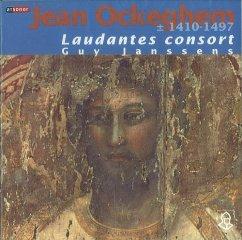Ockeghem - Motets, Missa Caput (1995)
Ockeghem - Motets, Missa Caput (1995)

Motets 1.Salve Regina 2.Intemerata Dei mater 3.Alma redemptoris mater Missa "Caput" 4.Kyrie 5.Gloria 6.Credo 7.Sanctus 8.Agnus Dei Requiem (excerpt) 9.Introitus Laudantes Consort Laure Delcampe (cantus), Thérèse Spitz (cantus), Mikiko Suzuki (cantus), Paul De Troyer (altus), Els Janssens (altus), Michèle Massina (altus), Jacques Antoine (tenor), Joris Bosman (tenor), Philippe De Clerck (tenor), Conor Biggs (bassus), Patrick Ringal-Daxhelet (bassus), Fabrice van de Putte (bassus). Guy Janssens - director
The Cyclic Mass -- linking all five movements of the Mass Ordinary by musical means -- became the premiere genre for composers in the fifteenth century. Mass cycle compositions could honor specific patrons, suggest specific liturgical (or courtly) contexts, and could serve as musical communication between different composers, either as homage or one-upmanship. A rich early complex of such related Mass settings begins with an anonymous English "Caput" Mass (from the 1440s, falsely attributed to Guillaume Dufay), which apparently inspired the Missa Caput of Johannes Ockeghem. Another great Flemish composer, Jacob Obrecht, later in the century, would compose his own Missa Caput. Each of the latter two betrays intimate knowledge of its predecessors; each takes pride in more compositional complexity than the other.
Ockeghem's Missa Caput survives in two manuscript sources, the earlier one (one of the "Trent Codices") likely copied around 1462; there is some evidence, however, for an earlier lost copy. The anonymous English Mass of the same name also survives in mid-century Continental sources, and Ockeghem probably encountered it while working in the Netherlands. Both Caput Masses use a single plainchant melody as a cantus firmus to relate all five movements; the melodic source has been established as a long melisma on the word "caput" in the Sarum (English) chant "Venit ad Petrum." In straightforward practice, all movements of the English Mass contain one or two iterations of the melody, in long-notes in the Tenor voice. Ockeghem's rhythmic elaboration and structural application of the cantus firmus is nearly identical. However, he poses himself a radical compositional challenge by requiring this voice to be sung down an octave -- thus in the Bass range.
The preordained notes of the cantus firmus melisma contain very few fourths or fifths, Bass intervals which are helpful for facile harmonic progressions! Instead, the melody here provides an uncertain and often disjointed modal foundation. From the opening chords of the Kyrie, harmonic surprises reign. Furthermore, the prevalence in the melody of the pitch, B natural, causes a large number of harmonic conflicts with the pitch F. Some of these must be solved by correction to F sharp, a pitch of which the musical theory of Ockeghem's time did not acknowledge the "real" existence; many must stand as "devil's interval" tritones. It is as if the young Ockeghem was deliberately subverting his own musical system to give himself a compositional challenge. The music which results is an aurally rich, and often disturbing, creation, its harmonies proceeding under the influence of an arcane and nearly alien logic. ---Timothy Dickey, allmusic.com
download (mp3 @320 kbs):
yandex mediafire uloz.to cloudmailru gett








